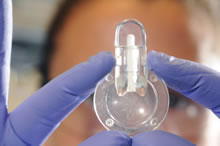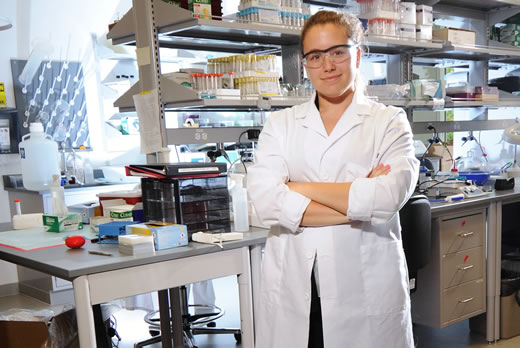A simple point-of-care testing device for anemia could provide more rapid diagnosis of the common blood disorder and allow inexpensive at-home self-monitoring of persons with chronic forms of the disease.
The disposable self-testing device analyzes a single droplet of blood using a chemical reagent that produces visible color changes corresponding to different levels of anemia. The basic test produces results in about 60 seconds and requires no electrical power. A companion smartphone application can automatically correlate the visual results to specific blood hemoglobin levels.
By allowing rapid diagnosis and more convenient monitoring of patients with chronic anemia, the device could help patients receive treatment before the disease becomes severe, potentially heading off emergency room visits and hospitalizations. Anemia, which affects two billion people worldwide, is now diagnosed and monitored using blood tests done with costly test equipment maintained in hospitals, clinics or commercial laboratories.
Because of its simplicity and ability to deliver results without electricity, the device could also be used in resource-poor nations.
A paper describing the device and comparing its sensitivity to gold-standard anemia testing was published August 30 in The Journal of Clinical Investigation. Development of the test has been supported by the FDA-funded Atlantic Pediatric Device Consortium, the Georgia Research Alliance, Children's Healthcare of Atlanta, the Georgia Center of Innovation for Manufacturing and the Global Center for Medical Innovation.
"Our goal is to get this device into patients' hands so they can diagnose and monitor anemia themselves," said Dr. Wilbur Lam, senior author of the paper and a physician in the Aflac Cancer and Blood Disorders Center at Children's Healthcare of Atlanta and the Department of Pediatrics at the Emory University School of Medicine. "Patients could use this device in a way that's very similar to how diabetics use glucose-monitoring devices, but this will be even simpler because this is a visual-based test that doesn't require an additional electrical device to analyze the results."
The test device was developed in a collaboration of Emory University, Children's Healthcare of Atlanta and the Georgia Institute of Technology – all based in Atlanta. It grew out of a 2011 undergraduate senior design project in the Wallace H. Coulter Department of Biomedical Engineering at Georgia Tech and Emory University. In 2013, it was among the winners of Georgia Tech's InVenture Prize, an innovation competition for undergraduate students, and won first place in the Ideas to SERVE Competition in Georgia Tech's Scheller College of Business.

Device prototype
Using a two-piece prototype device, the test works this way: A patient sticks a finger with a lance similar to those used by diabetics to produce a droplet of blood. The device's cap, a small vial, is then touched to the droplet, drawing in a precise amount of blood using capillary action. The cap containing the blood sample is then placed onto the body of the clear plastic test kit, which contains the chemical reagent. After the cap is closed, the device is briefly shaken to mix the blood and reagent.
"When the capillary is filled, we have a very precise volume of blood, about five microliters, which is less than a droplet – much less than what is required by other anemia tests," explained Erika Tyburski, the paper's first author and leader of the undergraduate team that developed the device.
Blood hemoglobin then serves as a catalyst for a reduction-oxidation reaction that takes place in the device. After about 45 seconds, the reaction is complete and the patient sees a color ranging from green-blue to red, indicating the degree of anemia.
A label on the device helps with interpretation of the color, or the device could be photographed with a smartphone running an application written by Georgia Tech undergraduate student Alex Weiss and graduate student William Stoy. The app automatically correlates the color to a specific hemoglobin level, and could one day be used to report the data to a physician.
To evaluate sensitivity and specificity of the device, Tyburski studied blood taken from 238 patients, some of them children at Children's Healthcare of Atlanta and the others adults at Emory University's Winship Cancer Institute. Each blood sample was tested four times using the device, and the results were compared to reports provided by conventional hematology analyzers.
The work showed that the results of the one-minute test were consistent with those of the conventional analysis. The smartphone app produced the best results for measuring severe anemia.
"The test doesn't require a skilled technician or a draw of venous blood and you see the results immediately," said Lam, who is also an assistant professor in the Coulter Department of Biomedical Engineering. "We think this is an empowering system, both for the general public and for our patients."
Tyburski and Lam have teamed up with two other partners and worked with Emory's Office of Technology Transfer to launch a startup company, Sanguina, to commercialize the test, which will be known as AnemoCheck™. The test ultimately will require approval from the FDA. The team also plans to study how the test may be applied to specific diseases, such as sickle cell anemia – which is common in Georgia.
The device could be on pharmacy shelves sometime in 2016, where it might help people like Tyburski, who has suffered mild anemia most of her life. "If I'd had this when I was kid, I could have avoided some trips to the emergency room when I passed out in gym class," she said.
About a third of the population is at risk for anemia, which can cause neurocognitive deficits in children, organ failure and less serious effects such as chronic fatigue. Women, children, the elderly and those with chronic conditions such as kidney disease are more likely to suffer from anemia.
Writer: John Toon, Georgia Tech

